The Friendly Impressionist
Pierre-Auguste Renoir created some of the most charming paintings of impressionist art. Trained as a porcelain painter, he made the transition from artisan to artist at the age of 19. Throughout his long career, and despite many changes of style, his paintings always remained joyful. They evoke a dreamy, carefree world full of light and colour where beautiful women dance with their lovers.
After struggling for more than 15 years - his Impressionist canvases were derided by the critics - Renoir made his name as a society portrait painter when he was nearly 40. Around this time he married and settled into a happy family life. Later he became crippled by rheumatism and moved south to the Riviera, where he spent his final years painting every day until his death at the age of 78.
Pierre-Auguste Renoir was born at Limoges in mid-France on 25 February 1841, the fourth of his parents' five children. His father Léonard was a tailor, his mother, Marguerite, a seamstress. The family moved to Paris when Renoir was aged four so he grew up in the capital - at first in a run-down apartment in the courtyard of the Louvre, which was then still a royal palace.
Paris in the 1840s
The Renoir household was crowded and hardworking, but the boy had a happy childhood distinguished by the discovery that he had a beautiful voice. The composer Gounod proposed to arrange a complete musical education for him, with a place in the chorus of the Paris Opera. But even at 13, Renoir somehow felt that he was not 'made for that sort of thing'. Instead, he took up another offer - he became an apprentice decorative painter in a small porcelain factory.
19th century Limoges porcelain casket
Auguste proved so skilful at the job that he was nick-named Mr Rubens and was soon given the task of painting profiles of Marie-Antoinette on the fine white cups.
He earned a good living at this craft for five years, before the job of hand-painting was made obsolete by the invention of a mechanical stamping process. It was his first real contact with 'the machine', and turned him against mass-production and standardisation for life.
During his time at the factory, Renoir would visit the art galleries of the Louvre during his lunch period.
Gallery of the Louvre (1831-1833) by Samuel Morse
His great loves were the exquisite 18th century pictures of courtly gaiety painted by Watteau, Boucher and Fragonard, and the dramatic colourful canvases of Delacroix. But as he told his sun, Jean, he was most inspired by a superb 16th-century sculpture, the Fountain of the Innocents.
And after a year spent painting blinds and a series of murals for cafés, he decided to become an artist.
In 1862, at the age of 21, Renoir became a student at the studio of Charles Gleyre, a very well-known private art school in Paris. Though academic and traditional in character, it gave him an excellent training with plenty of time to go to the Louvre and study the Old Masters. But Gleyre also stressed the importance of sketching out-of-doors, and encouraged him to visit the Forest of Fontainebleau.
Forest Paths, Pierre-Auguste Renoir (1875)
During his visits to Fontainebleau, Renoir often stayed at Mother Anthony's Inn, situated in the tiny village of Marlotte. In 1866, he painted his friends there: Monet (reaching for his tobacco), Sisley (in a hat) and Jules LeCoeur.
Mother Antony's Inn (1866)
This feature of Gleyre's teaching and his remarkable group of young art students had a profound effect on Renoir's career.
Among the students were Claud Monet, Alfred Sisley and Frédérick Bazille, through whom Renoir met Edgar Degas and Edouard Manet, as well as many leading writers and critics. Together they gradually forged a close-knit group that met regularly in the Paris cafés to discuss their theories, and the ideas of Impressionism emerged.
Working closely with Monet in the Forest of Fontainebleau, (a two-day walk from Paris), Renoir gradually developed his own style.
Monet Painting in His Garden at Argenteouil, Renoir (1873)
But their collaboration reached a climax in the summer of 1869 when, working together at the popular river-side restaurant known as La Grenouillère, the two men produced the canvases which are now regarded as the first Impressionist paintings.
Renoir met Lise Tréhot when he was in his early twenties and she was just 16: her sister lived with Renoir's friend and fellow-artist Jules LeCoeur in Marlotte village.
Photo of Lise Tréhot
The Artist was attracted by the young girl's dark, pretty features and rounded figure. She soon became his favourite model - and mistress. He painted her more than 20 times between 1865 and 1872: in that year, the couple parted and Lise married. She never saw Renoir again.
Renoir delighted in painting Lise in different guises.
The Odalisque, Renior (1870)
In The Odalisque, he painted her as an Algerian harem-girl with an inviting look in her eye. Her exotic, sumptuous dress and openly seductive pose are far from the demure post-master's daughter in the photograph.
These were days of financial hardship for both Renoir and Monet. Renoir at least had some help from his family, and took bread and scraps from his table for Monet. But neither had money to spare for paint or canvas. It was only funds from Bazille, who had a small private income, which kept them going.


In 1870, this period of intense creativity was brought to an abrupt halt by the Franco-Prussian War. Renoir was called up, and found himself training horses for the cavalry in the Pyrenees, far from the fighting. He returned to Paris in the middle of the bitter Commune battle of 1871, but was lucky enough to have influential friends on both sides who made it possible for him to travel in and out of the city.
After Frances defeat by the Germans, angry Parisians rebelled against their republican government and formed a Commune. These were bloody days, and Renoir was once arrested as a spy, only to be saved from the firing squad by one of the Commune leaders whom he had once protected. He also had influential friends on the Republican side: while others were kept in or out of the city, Renoir passed freely between Communard Paris and Republican France.
He continued to paint and the group of artists slowly returned, though without Bazille; who had been killed in the war. Through Monet, Renoir now met Paul Durand-Ruel, the first art-dealer to support the Impressionists, who agreed to take his work. Soon he was selling enough to move into a large studio in the Rue St Georges. After a sequence of garret studios over the years, he now laughingly declared he had 'arrived'.
Renoir in his 30s
Skinny, bearded and immensely charming, with a nervous, modest manner, Renoir inspired extraordinary affection among his friends. Although not demonstrative - he hated any public show of emotion - he showed intense loyalty and love with acts of quiet generosity. One of his lifelong friends, the artist Paul Cézanne, was the complete opposite.
Where Cézanne was suspicious of people, Renoir would not waste his energy worrying about being exploited. 'People love to be nice,' he said, 'but you must give them the chance.'
Even with the new studio, Renoir's money problems were far from over. During the 1870s his work, like that of other Impressionist painters, was ignored or ridiculed by the academic critics - one of his nudes was compared to a 'mass of rotting flesh'.
Study Torso Sunlight Effect (c1876)
But gradually, a small and devoted band of enthusiasts developed. One of them, Victor Chocquer, became a particular admirer and proceeded to form a considerable collection of Renoir's work. This gave the painter enormous confidence at a difficult time, but on its own it was not enough to support him. He was still dependent on portrait commissions gained via the Salon, until enlightened middle-class families like the Charpentiers and the Bérards became his patrons, enabling him to continue with the more experimental Parisian scenes.
Portrait of Mlle Georgette Charpentier by Renoir (1876)
Through all these years Renoir had remained a bachelor. There had been romances, notably with Lise Tréhot, whom he painted so often in the 1860s, but Renoir seems always to have regarded the idea of marriage and children as a distraction from the focus of his life - painting.
But around the age of 40, he met Aline Charigot, a pretty girl some 20 years younger than himself, who had occasionally modelled for him.
Paul Lôte & Aline, detail from Dancing in the Country (1883)
Their relationship developed during the summer of 1881, while he was working on the great masterpiece of his Impressionist period, The Luncheon of the Boating Party, for which Aline was one of the models.
The Luncheon of the Boating Party (1880-1881)
He taught her to swim, and they danced and went boating together. The gentle Aline had almond eyes and 'she walked on the grass without hearting it', but though they loved each other, their affair was not to be straightforward.
Renoir was at a crisis in his painting. Despite Aline's suggestion that they should go and stay in her small home village of Essoyes in Burgundy, he was reluctant to leave Paris and equally reluctant to have children. Aline called things off. Renoir began to travel intensively: first to Normandy, then Algeria, a country he associated with Delacroix, then to Spain and Italy to see the works of the Old Masters - Velazquez in Madrid, Titian in Venice, Raphael in Rome and the murals at Pompeii.
Portrait of Tommaso Inghirami by Raphael (1510-14)
But Renoir did not forget Aline, and returned to Paris to marry her. It was to be a marriage of harmony and happiness. She brought him peace of mind as well as children whom he could paint and, as he put it, 'Time to think. She kept an atmosphere of activity around me exactly suited to my needs and concerns'
But in his old Rue St Georges studio, Renoir absorbed the visual impressions of his travels into a new way of painting.
The Test Garden in Algiers (1882)
The so-called 'harsh' style he developed first created difficulties for his dealer, and it was only the huge enthusiasm of Americans for his work from 1885 that enabled Renoir to support his wife and newly-born son Pierre in reasonable comfort.
Though not yet rich, Renoir was able to move with his family to a larger house in Montmartre and to take on help for Aline. Gabrielle Renard, a distant cousin of Aline's; arrived in 1894. Aged just 15, she had never before left the village of Assones in Burgundy where she and Aline were born. The rosy-skinned, dark-haired young girl soon became part of the family, helping to bring up the younger suns Jean and Claude, and frequently posed as a model.
Family photo with Gabrielle on the right
Renoir enjoyed family life, working hard - and by how selling well - seeing friends every Saturday night, when Aline would hold 'open house', and visiting his mother on Sundays. But disaster was soon to strike in the form of a serious illness. In 1897, he broke his arm falling off a bicycle, and this mishap brought on the first attack of the muscular rheumatism that slowly started to cripple him and never left him free from pain for the rest of his life. By enormous force of will, aided by the devotions of Aline, Gabrielle and their friends, he somehow continued to paint.
Renoir enjoyed family life, working hard - and by how selling well - seeing friends every Saturday night, when Aline would hold 'open house', and visiting his mother on Sundays. But disaster was soon to strike in the form of a serious illness. In 1897, he broke his arm falling off a bicycle, and this mishap brought on the first attack of the muscular rheumatism that slowly started to cripple him and never left him free from pain for the rest of his life. By enormous force of will, aided by the devotions of Aline, Gabrielle and their friends, he somehow continued to paint.
Photo of Renoir at 57, following the funeral of the poet Stephane Malarme in 1898
To relieve the rheumatic pain, Renoir spent increasingly long periods in the warmth of the South of France. In 1907, he built a beautiful house in Cagnes on the Riviera. With its many olive trees and orange blossom, and its views over the Mediterranean, 'Les Collettes' became his base for painting. The brilliant light and relaxed atmosphere helped ease his muscular pain and released a flood of creativity in a colourful classic style.
Modern view of Cagnes-sur-mer
However, the beauty of the place could not cure rheumatism. By 1907 Renoir could only walk with sticks. By 1912, his arms and legs were crippled and he was confined to a wheelchair. Nonetheless he continued to paint virtually non-stop, only halting briefly at Aline's death in 1915
In his last years, Renoir took up sculpture - with two young sculptors acting as his hands, since his own were too crippled to use. The fact that these sculptures are unmistakably Renoir's bears witness to his exceptional ability to communicate.
Renoir Sculpture Mother and Child c. 1916, cast 1927
Renoir painted to the end, working in a special glass studio in his garden. He was carried their daily in his sedan chair, always wearing his white out-of-doors hat, and placed in his wheelchair. Gabrielle would push the paintbrush between his twisted fingers. One day, after Renoir had painted some anemones a made had brought him, he asked a friend to take his brush, saying 'I think I am beginning to understand something about it.' He died later that night, on 3 December 1919.
Renoir is buried next to his wife, Aline, in her hometown of Essoyes in Burgundy
For Renoir, painting was a way of expressing his pleasure in life. He always enjoyed portraying his friends and lovers, and was never ashamed of making pretty pictures. 'Why shouldn't art be pretty?' Renoir asked once. 'There are enough unpleasant things in the world.' This simple statement sums up his attitude to both life and painting. He had a tremendous capacity for enjoyment, and his art was an expression of his pleasure in life. Renoir only worked when he felt happy, and he deliberately chose subjects that he considered attractive: lush landscapes, fruit and flowers, people enjoying themselves, children playing and, above all, beautiful women.
Nothing gave him greater pleasure than painting women, and although our idea of fashionable beauty may have changed considerably since Renoir's time, the young women we see in his paintings still evoke an era when living in Paris was fun. He was brought up the son of a tailor in the centre of the city, and his models were invariably working girls - seamstresses, milliners, actresses - who, he once said, had the precious gift of living for the moment.
Natural as it seems now, Renoir's choice of subject mater was radical and daring when he decided at the age of 21 to become a painter. The Paris art world was still dominated by the official Salon, which preferred to exhibit works on historical and literary themes, painted in a realistic style. Only in the past few years had younger artists, notably Gustave Courbet, turned to everyday subjects which were more expressive of a fast-changing France.
Bonjour, Monsieur Courbet by Gustave Courbet (1854)
The painting shown above is perhaps untypical of the work of Courbet, who pained mostly in dark colours.
The painting shown above is perhaps untypical of the work of Courbet, who pained mostly in dark colours.
Renoir quickly found that he was more interested in life on the street corner than in the usual studio practice of copying plaster casts of antique sculpture His teacher could not persuade him that the big toe of a Roman consul should be any more majestic than the toe of a local coal man. One day, exasperated with his pupil, Gleyre said, 'No doubt you took up painting just to amuse yourself.' And Renoir replied, 'Certainly. if it didn't amuse me, I wouldn't be doing it.'
While studying at Gleyre's studio, Renoir became friendly with a group of fellow students, dominated by the dynamic personality of Claud Monet, who were later to become famous as the Impressionists. Together they went on painting trips to the Forest of Fontainebleau, 40 miles south of Paris, where they worked out in the open air. Renoir, very impressed by Courbet, used subdued browns and blacks in his work. But one day the artist Narcisse Diaz chanced upon him in the forest and, examining Renoir's canvas, asked 'Why the devil do you paint in such dark colours?'
In the Forest of Fontainebleau
This encouraged Renoir to use the lighter, rainbow colours he instinctively preferred and which he had learned to handle during his early years as a porcelain painter
During the late 1860s, Monet and Renoir worked very closely together, for they were both attracted by sparkling river scenes and views of bustling Paris. Several of their pictures at this time are of almost identical scenes, but Renoir's style is softer and more delicate than Monet's.
The Bridge at Chatou by Renoir (1875)
The Banks of the Seine at Petit-Gennevilliers (1874) by Monet
Working out of doors, where the light could not be controlled as in a studio, they had to paint quickly to capture the colours in nature before they changed - for example when clouds covered the sun, so they made no attempt to blend their brushstrokes in the traditional way. Instead they placed different colours side by side, in the manner soon to be generally described as Impressionism.
In paintings like Moss Rosses (c1880), Renoir discovered a wonderful form of relaxation: 'I just let my brain rest when I paint flowers', he said. In the 1890s he painted many pictures of roses, experimenting with the same flesh tints he used for his nudes.
Renoir enjoyed painting landscapes, but he was always more interested in people. Throughout his life he included his friends and lovers in his pictures. Initially, as a penniless artist, they were the only models available to him. Some of their faces are distinctly 'Renoir', with almond-shaped eyes and luxuriant hair, but what he looked for especially in a model was 'an air of serenity' and a good skin that 'took the light'. Some of Renoir's most successful early works are portraits, and his graceful, gentle style was particularly suited to painting children.
The Clever One (1874)
During his Impressionist years, Renoir developed a fascination with the effect of light passing through foliage to fall as dappled shadows on the ground, and on human forms.
Renoir painted this scene in the shady garden of his studio in Montmartre. He used bright blew for the shadows and yellow and pink for the pools of dappled sunlight. By contrasting cool with warm colours, he was able to suggest the brilliance of a sunny day. Renoir also used blew for the bows on the woman's pink dress, across which blue shadows dance. Behind, dots of light break up the blew shadow on the path into a rich pattern.
Several flower mills and plaster mills had stood on the top of Montmartre Hill for centuries, but when, in the 19th century, they began falling into disuse, the owners of one mill (moulin, in French), a family of millers, the Debrays, made profitable use of the sight by opening a café and gardens there, where they served galletes (pancakes) and Grenadine (a sweet French cordial). Down below, a hanger served as a dance hall, with music provided by an orchestra. In fine weather patrons could dance outside, as you see them doing below.

Le Moulin de la Galette (1876)
In this large, complex composition, Renoir used the light passing through the trees to unite his figures with their surroundings.
Throughout the 1870s Renoir exhibited regularly with the Impressionists, but he also submitted paintings to the Salon. He was always more traditional than the other Impressionists and never for a moment considered himself a revolutionary. While his anarchist friend, the painter Camille Pissarro, wanted to burn down the Louvre, Renoir was a frequent visitor to the gallery.
At first he saw no contradiction between his Impressionist insistence on painting directly from nature and his reverent study of Old Masters. But in 1883, following a trip to Italy, Renoir was no longer able to reconcile the two. H told a friend, 'I had travelled as far as Impressionism could take me and I realised that I could neither paint nor draw.' Subsequently, Renoir dramatically changed his style, and developed a 'harsh' technique, surrounding his figures with hard, sinuous outlines. In The Bathers he adopted the Old Masters' method of making detailed preparatory drawings. The resulting work is as flat and decorative as a mural at Pompeii.
The Bathers (1884)
By the 1890s, these hard colours had melted again as Renoir returned to a style more in harmony with his interests. He began to use warmer colours, especially reds, possibly as a result of two earlier trips to Algeria, where he had been most impressed by the hot, sultry light.
He painted his children, with their able and active nurse, Gabrielle,
Gabrielle and Jean (1895)
and a variety of sensual nudes, all glowing with radiant colour.
Sleeping Woman 1897
'I never think,' Renoir once said, 'that I have finished a nude, until I feel I could pinch it.'
The Making of a Masterpiece
The Luncheon of the Boating Party (1881)
The Making of a Masterpiece
Renoir began work on this chef d'oeuvre in the summer of 1881. It was a subject that he had been 'itching' to paint for some time, a merry group of friends lunching on the terrace of the Restaurant Fournaise at the Isle of Chatou on the River Seine. A friend named Baron Bardier, a good-natured regimental captain who much preferred horses to paintings, volunteered to stage-manage the affair, rounding up all Renoir's friends and even making sure the boats were properly positioned for the background. Then Renoir began to make studies and sketches on the spot. The result is an Impressionist masterpiece, filled with a spirit of 'joie de vivre'. But the picture marked the end of an era. Shortly afterwards Renoir changed his stile.
The boats glimpsed in the background remind us that the friends relaxing over lunch have just returned from the river.
The young woman, shown in a remarkably natural pose, is Aline Charigot, Renoir's wife-to-be. The Restaurant Fournase was their favourite meeting place at the time.
Renoir's skill as a painter is shown in this sparkling still-life. The bottles and glasses take on all the colours of the objects around them.
Picture Exhibition
La Grenouillère (1869)
La Grenouillère was a popular resort consisting of a spa, a boating establishment and a floating café, located on the Seine near Bougival. Renoir's sparkling picture of it was one of his first paintings in the new impressionist style. He and his friend Claud Monet both painted views of La Grenouillère. Working in the open air, they set up their easels side by side to paint the lively crowds and the reflections on the water.
La Loge (1874)
Renoir exhibited La Loge at the first Impressionist exhibition in 1874. His younger brother Edmond and a model called Nini posed for this picture in Renoir's studio. Nina was dressed up to look like a wealthy woman at the opera. The painting was bought by a dealer for 425 franks, which Renoir already owed in rent.
The First Night Out c.1876/7
In this magical painting, Renoir captured the wide-eyed excitement and nervous anticipation of a young girl on her first visit to the theatre. In her eagerness she leans forward, clasping her bouquet of flowers. The audience is painted in broad, sketchy brushstrokes and their blurred faces suggest the movement of their heads.
The Skiff (1879)
Renoir exhibited La Loge at the first Impressionist exhibition in 1874. His younger brother Edmond and a model called Nini posed for this picture in Renoir's studio. Nina was dressed up to look like a wealthy woman at the opera. The painting was bought by a dealer for 425 franks, which Renoir already owed in rent.
The First Night Out c.1876/7
In this magical painting, Renoir captured the wide-eyed excitement and nervous anticipation of a young girl on her first visit to the theatre. In her eagerness she leans forward, clasping her bouquet of flowers. The audience is painted in broad, sketchy brushstrokes and their blurred faces suggest the movement of their heads.
The Skiff (1879)
Renoir painted The Skiff on a happy summer's day at Asniès, concentrating on the glistening effect of sunlight on moving water. The contrasting colours, yellow-orange for the boat and bright blue for the water, contributed to the vibrancy of the scene. In the background, the steam-train from Paris is puffing through the landscape.
Renoir painted many still-lifes and flours. In this picture he selected fruits and vegetables that would lend themselves to a wonderful colour arrangement - among them red pimentos, purple-blue aubergines and yellow-green lemons.
In 1883 Renoir was commissioned to paint a pair of pictures contrasting the lifestyles of the town and the country. In this 'town' painting, the cool colours, impersonal setting and elegant dress of the dancers illustrate the sophisticated manners of well-to-do Parisians.
The Umbrellas c.1881-6
In this famous
picture, a Paris crowd braves the showers under a canopy of open
umbrellas.
After the Bath c.1888
In his later years,
Renoir’s favourite subject was the nude. He painted hundreds in
rich, glowing colours, revelling in their roundness and fullness of
form. ‘My concern,’ he said, ‘has always been to paint nudes as
if they were some splendid fruit.


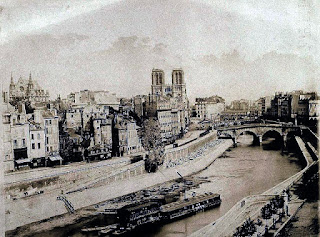





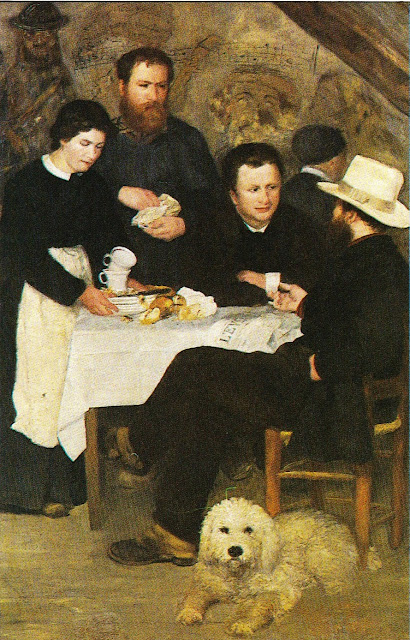

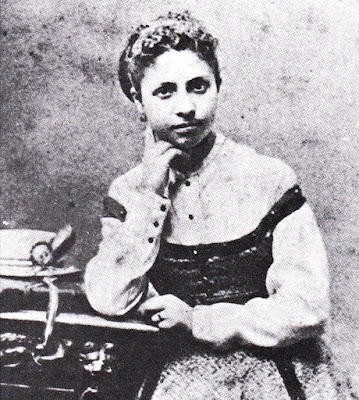
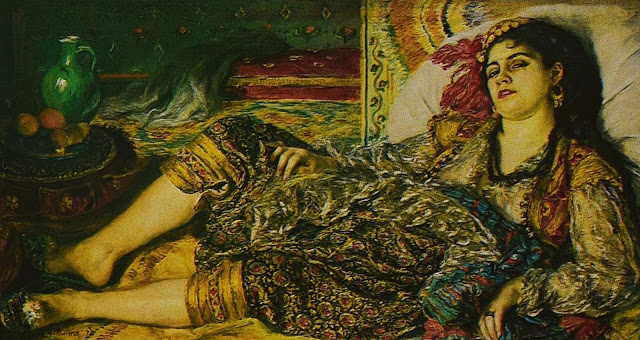


























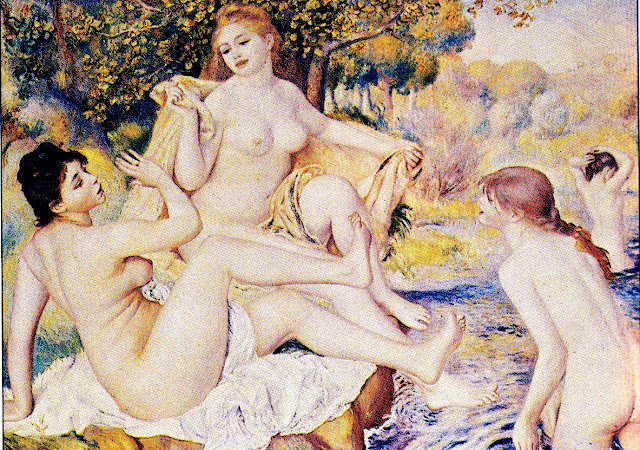










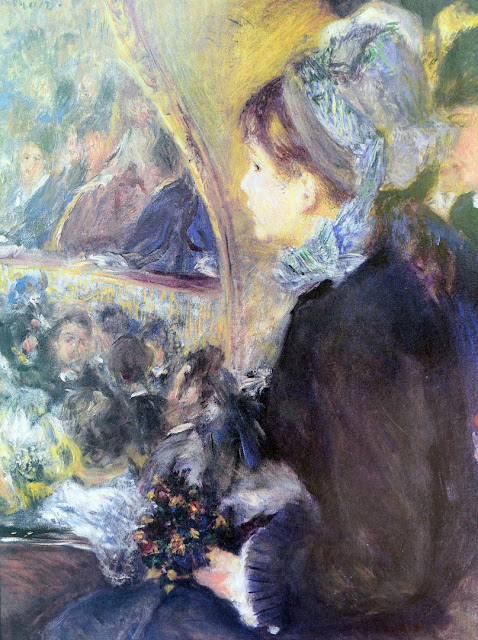







No comments:
Post a Comment